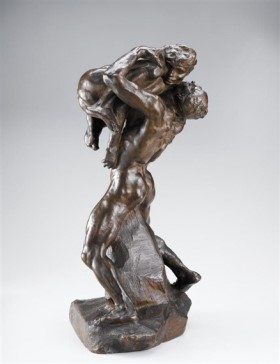Auguste Rodin: praise of envy ??

There is a fresco at Villa Maser1 near Treviso, where avarice is represented by an old and nake man, vaguely grinning, who waves a large key at a blonde woman representing generosity, much taller than him and protagonist of the scene : the woman carries a bunfle of ears of mature corn. Between the two it’s clear there is no link, though he tends to her, almost desperately, to be heard. Perhaps she hears him, but is not looking for him.
Visiting the nice exhibition about Auguste Rodin2 at Treviso, cared by Marco Goldin who offered to the public the works of a Master till now hosted only in France, his native country, I’ve thought that a few little statues, well lit and placed but not central in the place, or maybe even considered a little obscure in Rodin’s production, reveal what the artist really thinks of, and with a descriptive precision which the big statues presented at the entrance and in the centre of the exhibition, and representative by now of his whole work at the general public, didn’t have, as a matter of facts.3
The two little statues are : “Je suis belle", of which there seems to be more than a subject, and "Fugit amor"4 : even if both are small in size, they are very elaborate statues - as I hope you can understand from the photo I chose for this article. Unlike the portraits commissioned to him5, these two sculptures reveal a commitment of the author, sincer passionate but dimed by despair.
In "Je suis belle", the undefended naked shape of a man leaps forward holding up in the air a young woman curled up in the fetal position, but escaping his own kiss. An unusual subject indeed, mainly for the years when Rodin lived, who fed on the vital explosion of impressionist painting, open to the disruptive experience towards tradition and enthusiastic of a work ‘en plein air’ and among people, in antithesis to solitary heroism, generous but unsatisfied, of Romantic literature6.
Rodin uses the enthusiasm of Impressionism to slip back into a Romantic illusion, giving up a new solution where indeed Matisse at first, and Picasso7 then involved themselves.
He’s a man full of virility, the one of "Je suis belle", who looks sideways at the woman-foetus who escapes him, so curled up and shown just above his own abdomen : banner of a presumed power which is not given to man, tempting him to an envy that by avarice is generated ?
The representation is plausible of a defense as impetuous as it is naive of sexual authonomy, phallic and romantic, condemned to impotence by the sole refusal from her, who distances her own face from the face of him.
All Rodin’s production revolves around a thought involved, even obsessively, by the creation8 and however also by the human possession which the biblic Creation nothing has to do, because God creates man free to produce one’s own destiny.
Rodin instead fears to miss what he creates, his own biography tells about a greedy humanity and not available to let itself be inherited : his recurrent theme are the hands, yes shaping but also intrusive, possessive, envious of others.
Just like in “Je suis belle”, good title indeed for what the author thinks of the woman who dismisses the man leaving him defenseless to his passions. A melancholy and envious thought which Rodin offers again in “Fugit amor” where the two lovers, like mermaids floating in the sea, elude each other – she always a little ahead of him – in a likewise damned, deadly, unreasonably desired conception of loving thought.
In his melancholy, Rodin envies that presumed sexual autonomy which woman would find in motherwood, an exclusive and coveted place of satisfaction that Nature denies to man.
It surprises the emotional grip which Rodin maintains on contemporary audiences, albeit hyper-connected, algorithmic and digitally cultured but which also testifies the strength of a resistance to judge that goes on to spread naivety, and an easy envy.
Favouring emotion which removes judgement, as a matter of facts Rodin knocks out any solution, human and possible : which Henry Matisse, on the other hand – and shortly after, Picasso too – came to propose profitably.
Marina Bilotta Membretti / Cernusco sul Naviglio - May 28, 2018
1 ‘Villa Maser’ near Treviso, by Andrea Palladio (1508 - 1580), Renaissance highly regarded architect and scene designer, considered one of the most influential personality in Western architecture history.
2 The exhibition (February 24 – June 3, 2018) which rounds off the celebrations for the death’s centenary of Auguste Rodin (1840-1917) was promoted by the Municipality of Treviso, by Marco Goldin and by "Linea d'ombra", which also produced it and organized, with a fine setting at the Museum of ‘Santa Caterina’.
3 "The Cathedral" (1908), "Adam and Eva" (1881), "The thinker" (1880), "The kiss" (1882).
4 "Je suis belle" (1882), "Fugit amor" (1887).
5 "Madame Vicuna" (1884) and other portraits commissioned to Rodin, remain timid and vaguely celebratory works.
6 Ugo Foscolo (1778-1827) in Italy, J.W. Von Goethe (1749-1832) in Germany, V.Hugo ((1802-1885) in France.
7 H.E.B.Matisse (1869-1954); P.Picasso (1881-1973)
8 "The Cathedral" (1908) is represented by two large hands, approached in a singular way to form a welcoming and protecting place.

